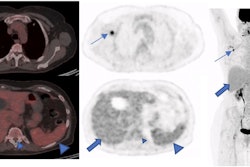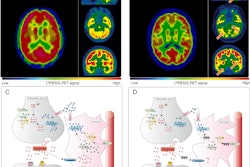CT imaging reveals the influence of blood glucose levels on the severity of COVID-19, researchers have reported.
A team led by Dan Lu, PhD, of Kunming Medical University in Yunnan, China, found that the quality of blood glucose control significantly correlated with patients' CT severity score, with higher blood glucose measured translating to higher severity of COVID-19's lung effects. The results were published April 23 in the Journal of Health, Population and Nutrition.
"Previous research has shown that, compared with normal infected individuals, patients with diabetes exhibit more severe conditions in terms of clinical course and chest imaging and are more likely to develop critical COVID-19," the group noted. "In addition, those with poor blood glucose control have a worse prognosis."
Lu's team investigated the effects of blood glucose levels on the severity of COVID-19 in a study that included 146 diabetic patients with the infection who presented at Yan'an Hospital in Kunming between December 2022 and January 2023. The patients were categorized into a "good" blood glucose control group (HbA1c less than 7%) and a "poor" blood glucose control group (HbA1c more than 7%). The investigators compared clinical data (i.e., blood lymphocyte, leukocyte, and C-reaction protein measures) and a total CT severity score to evaluate the severity of the COVID-19 infection. (A CT severity score of less than 8 is mild; 9 to 15, moderate, and higher than 15, severe.)
The investigators found that the two groups showed no statistically significant differences in the clinical measures or in pleural effusion, consolidation, ground-glass opacity, or crazy-paving signs on CT. But patients with poor blood glucose control showed a higher degree of lobar involvement and a higher total CT severity score than the group with good blood glucose control (13.3 compared with 10.38, p < 0.05).
They also reported that total CT severity score significantly influenced the clinical severity of COVID-19 in patients (odds ratio 1.6, p > 0.05).
Finally, the team wrote that the area under the curve (AUC) of CT severity score prediction of critical COVID-19 was 0.89. with sensitivity of 79.3% and specificity of 88.1% when the threshold value was a score of 12.
"Chest CT imaging is a reliable testing method for COVID-19 evaluation; the higher the blood glucose level is, the more evident the lung inflammation and the more severe the clinical manifestation," Lu and colleagues concluded. "This indicates that clinical patients should first receive a CT scan upon admission to evaluate their initial condition, and imaging appearances should be analyzed thoroughly. Targeted treatment should be administered, and publicity and education activities should be implemented aiming to popularize among patients with diabetes the necessity of controlling their blood glucose and encouraging them to make an active effort to keep healthy and follow appropriate diets, thus improving their quality of life."
The complete study can be found here.



















